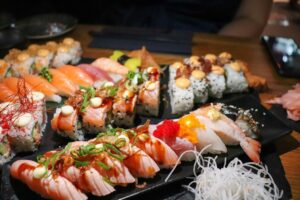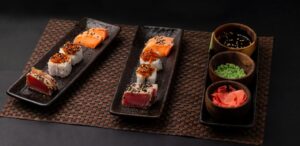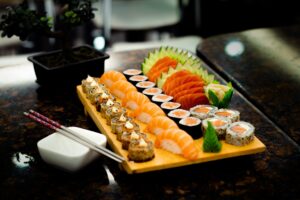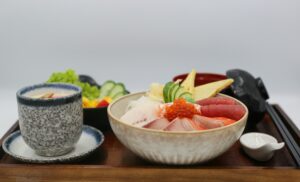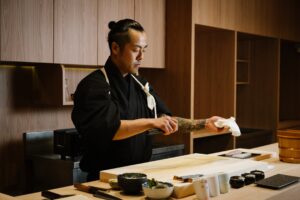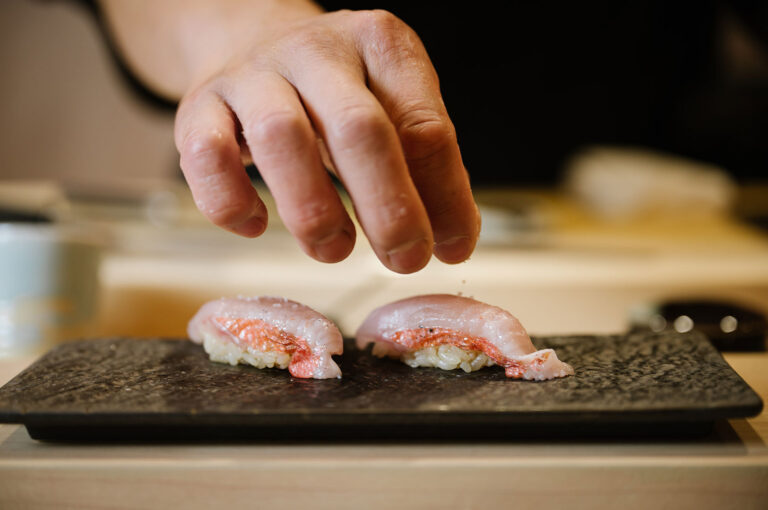
Sushi in Japanese: Understanding the Art and Language of Japan’s Most Celebrated Cuisine
When you sit at a sushi counter in Japan, you’re not just ordering food—you’re participating in a centuries-old culinary tradition that reflects the very essence of Japanese culture. The word “sushi” carries far more meaning than most diners realize, embodying principles of harmony, seasonality, and respect that define Japanese cuisine. Understanding sushi in Japanese context reveals layers of cultural significance, from ancient preservation techniques to modern omakase experiences.
At Sushi Masa by Ki-Setsu, we believe that appreciating authentic Japanese sushi begins with understanding its linguistic and cultural foundations. This comprehensive guide will take you through the etymology, history, and proper appreciation of sushi in Japanese tradition, helping you become a more informed and respectful diner.
What Does Sushi Mean in Japanese?
Sushi in Japanese literally combines two fundamental elements: “su” (酢), meaning vinegar, and “meshi” (飯), meaning rice. This etymology reveals the true heart of authentic Japanese sushi—it’s fundamentally about vinegared rice, not raw fish as many Western diners assume. The carefully seasoned sushi rice, known as shari, forms the foundation upon which all traditional sushi preparations are built.
The most common kanji for sushi today, 寿司, carries deeply auspicious meanings. The character 寿 (su) represents longevity and congratulations, while 司 (shi) relates to administration or mastery. This explains why sushi appears at special occasions throughout Japan, from business celebrations to New Year festivities. The combination suggests something that brings good fortune and represents mastery of craft.
Modern sushi in Japanese cuisine represents the perfect harmony between seasoned rice (shari) and fresh toppings (neta). This balance reflects the Japanese philosophical concept of wa (和), or harmony, where each element enhances rather than dominates the other. At Sushi Masa, we honor this traditional definition while showcasing authentic Japanese craftsmanship that has been refined over generations.
The precision required in sushi preparation—from rice temperature to vinegar balance—demonstrates why sushi chefs undergo years of training. Our chef understands that creating authentic Japanese sushi means respecting these fundamental principles that have defined the cuisine for centuries.
Historical Evolution of Sushi in Japanese Culture
The journey of sushi in Japanese culture spans over a millennium, evolving from practical preservation to celebrated cuisine. Narezushi origins trace to Southeast Asia during the 4th century, where communities along rivers developed fermentation techniques using salt and rice to preserve freshly caught fish. This method reached Japan during the 8th century, initially serving purely practical purposes in coastal communities.
Hanaya Yohei revolutionized sushi in 1824 Tokyo, creating modern nigiri zushi using fresh fish from Tokyo Bay. His innovation shortened preparation time from months to minutes, transforming sushi from preserved food to fast food suitable for busy Edo period city dwellers. During the Edo period, haya zushi emerged as a fast, vinegar-based sushi that marked a shift from fermented to quick preparation methods.
The Meiji Restoration (1868) brought refrigeration technology, expanding sushi availability beyond coastal areas. Ice houses and improved transportation allowed inland communities to enjoy fresh seafood, democratizing what had previously been limited to fishing villages and major ports. This period saw the establishment of sushi restaurants in major cities throughout Japan.
Post-World War II innovations included kaiten zushi (conveyor belt sushi), introduced by Yoshiaki Shiraishi in 1958. This system made sushi accessible to ordinary families while maintaining quality standards. The color-coded plates system allowed customers to control costs while experiencing authentic Japanese sushi in casual settings.
Regional Types of Sushi
Regional variations in Japanese sushi reflect local ingredients, cultural preferences, and historical influences.
Edomae zushi from the Tokyo Bay region features subtle vinegar rice and fresh local seafood, emphasizing the natural flavors of commonly used fish like kohada (gizzard shad) and anago (conger eel). This style prioritizes technical precision and seasonal awareness.
Kansai sushi from the Osaka and Kyoto region employs sweeter rice seasoning and pressed sushi techniques. The pressed sushi tradition, including oshi zushi and hako zushi, is characterized by its distinctive rectangular shape, which distinguishes it from other regional sushi presentations. This style developed in response to different preservation needs and aesthetic preferences. Osaka’s famous battera (pressed mackerel sushi) exemplifies this regional approach, combining mackerel with vinegared rice in rectangular shapes.
These regional preferences developed over centuries, shaped by local ingredients and cultural tastes. Tokyo’s proximity to Edo Bay provided abundant fresh seafood, encouraging the immediate consumption style of nigiri zushi. Meanwhile, Kansai’s merchant culture favored portable, visually appealing preparations suitable for business entertaining and special occasions.
Traditional Sushi Types You’ll Find in Japan
Traditional Japanese sushi encompasses diverse preparations, each showcasing different aspects of culinary philosophy and seasonal ingredients. These time-tested forms remain popular throughout Japan, from high-end establishments to neighborhood sushi restaurants.
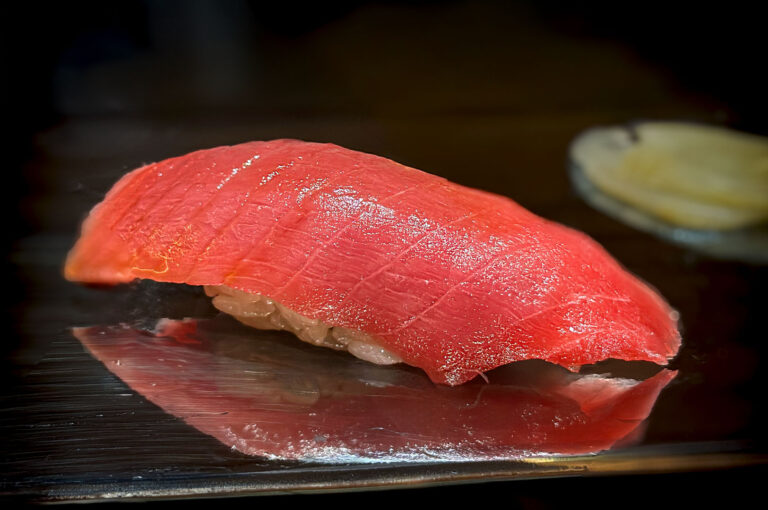
Nigiri Sushi
Nigiri zushi represents the most recognized form worldwide, featuring hand-pressed sushi rice topped with fresh fish. The technique requires years to master, balancing rice temperature, fish placement, and portion size. Proper nigiri zushi maintains body temperature (around 98°F) to release optimal flavors when consumed immediately.
Maki Sushi
Maki zushi is a type of sushi roll that includes various rolled preparations, from simple hosomaki (thin rolls) to elaborate futomaki (thick rolls). The nori (seaweed) provides structural support while contributing oceanic flavors. A sushi roll filled with ingredients such as cucumber, raw tuna, or even fermented soybeans (as in natto maki) offers a range of flavors and textures. Traditional maki zushi features seasonal ingredients like cucumber in kappa maki or pickled daikon in oshinko maki.
Chirashi Sushi
Chirashi zushi, literally meaning “scattered sushi,” presents various toppings over seasoned rice in a bowl. This style allows for creative seasonal presentations while maintaining the fundamental sushi rice foundation. Premium chirashi zushi might feature sea urchin, fish roe, and carefully prepared white fish.
Oshi Sushi
Oshi zushi (pressed sushi) uses wooden molds to create uniform rectangular shapes. This traditional technique from the Kansai region produces visually striking presentations, particularly popular for mackerel sushi and other oily fish that benefit from gentle pressing.
Inari Sushi
Inari zushi consists of sweet seasoned rice enclosed in fried tofu pouches. Named after the Shinto deity Inari, this preparation remains popular throughout Japan for its accessibility and satisfying flavors. The sweet-savory contrast demonstrates the Japanese appreciation for balanced taste profiles.
Sashimi
Sashimi, while often served alongside sushi, consists of thinly sliced raw fish or meat served without rice, highlighting its distinction from sushi.
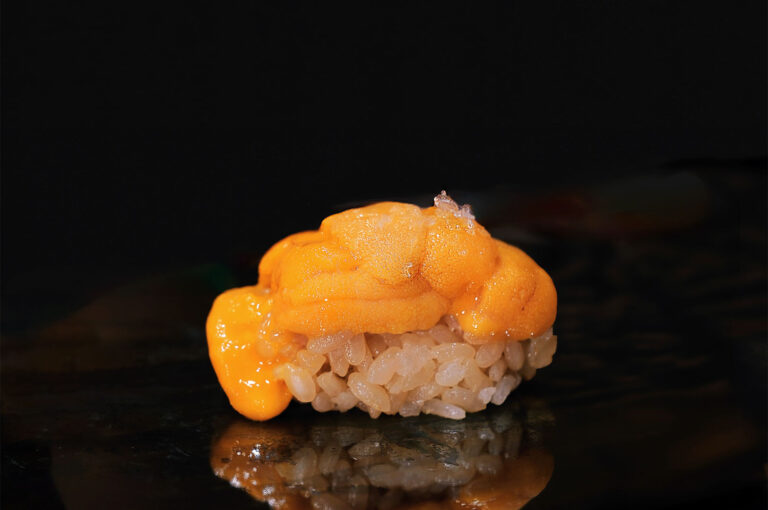
Essential Sushi Fish Names in Japanese
Understanding fish names in Japanese enhances communication with sushi chefs and demonstrates respect for Japanese cuisine traditions. These terms appear on menus throughout Japan and help diners make informed selections based on flavor preferences and seasonal availability.
Maguro (まぐろ) encompasses various tuna classifications, from akami (lean red meat) to the prized otoro (fatty belly). Chutoro represents medium-fatty portions, offering balanced richness between akami and otoro. Premium establishments often specify tuna origins, with Tsukiji market sourcing particularly prestigious.
Sake (さけ), referring to salmon, gained popularity in Japanese sushi relatively recently, introduced widely in the 1990s. Atlantic salmon became commonly served after Norwegian promotion efforts, though traditional establishments may emphasize seasonal wild varieties when available. Salmon sushi has become especially popular in Western-style sushi innovations, such as the California roll and uramaki.
Hamachi (はまち) designates young yellowtail, prized for its buttery texture and mild flavor. This fish represents autumn and winter seasonality, when cold water feeding produces optimal fat content. Mature yellowtail (buri) offers different characteristics, appreciated by experienced sushi diners.
Tai (たい), sea bream, holds special significance in Japanese culture as the “king of white fish.” Its firm texture and subtle flavor make it ideal for showcasing rice preparation and knife skills. Red sea bream appears frequently at celebratory meals due to its auspicious associations.
Uni (うに), sea urchin roe, varies significantly by region and season. Hokkaido and Kyushu produce premium varieties with distinct flavor profiles, from sweet and creamy to briny flavor, combining salty and oceanic notes that reflect its marine origin. Understanding uni seasonality helps diners experience optimal preparations.
Tuna, salmon, yellowtail, mackerel, and other shellfish are among the most popular seafoods used in sushi, valued for their quality and flavor.
Shellfish and Specialty Seafood
Tako (たこ) refers to octopus, traditionally boiled and thinly sliced to achieve proper texture. The preparation requires skill to balance tenderness with structural integrity, making it a measure of sushi chef competency.
Ebi (えび) encompasses cooked shrimp preparations, while amaebi describes sweet raw shrimp varieties. The distinction matters when ordering, as cooking methods significantly affect flavor and texture profiles.
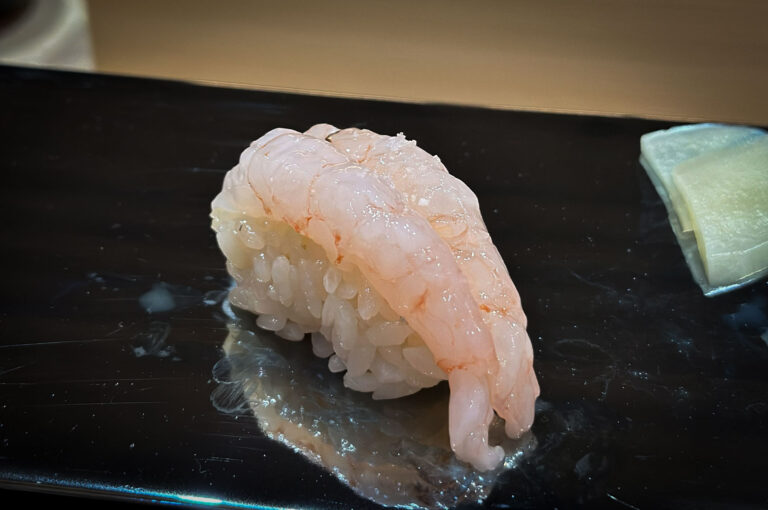
Hotate (ほたて) designates scallop, typically served raw to preserve natural sweetness. Premium scallops from northern waters offer particularly prized texture and flavor, especially during colder months when natural flavors peak.
Ikura (いくら) refers to salmon roe, commonly served as gunkan maki due to its soft texture. The distinctive orange color and bursting texture make it popular among diners seeking dramatic flavor experiences.
Each seafood selection represents specific seasons and regional Japanese fishing traditions. At Sushi Masa, we emphasize seasonal selections that honor these traditional associations while showcasing the finest available ingredients through our omakase Singapore experience.
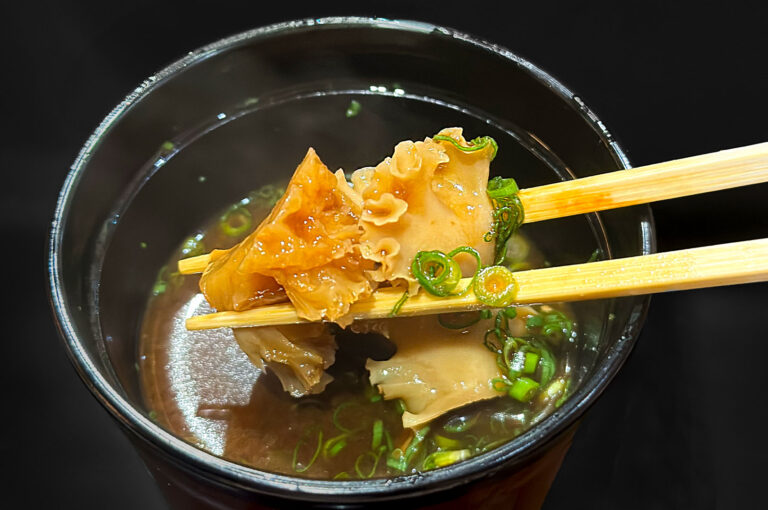
Proper Sushi Etiquette in Japanese Culture
Understanding proper etiquette enhances the dining experience and shows respect for Japanese cuisine traditions. These practices, developed over centuries, reflect cultural values of harmony, respect, and craftsmanship.
Eating sushi with hands or chopsticks is equally acceptable, with consistency more important than method. Gentle handling preserves rice structure and transfers optimal temperature from hand to mouth.
Soy sauce use requires restraint. Dipping only the topping (neta) lightly in shoyu preserves the chef’s seasoning and prevents rice from absorbing too much sauce. Excessive soy sauce overwhelms delicate flavors and suggests inexperience.
Eating each piece in one bite ensures the intended harmony between rice and neta. This respects the chef’s portioning and delivers optimal temperature and texture.
Order progression traditionally goes from mild to strong flavors: white fish, red fish, then specialty rolls. This prevents strong tastes from overpowering subtle ones and allows full appreciation.
Respect for ingredients and the chef’s skill is central to Japanese dining. Acknowledging seasonal selections, asking about preparation, and expressing appreciation enhances the experience.
Counter Dining Customs
Counter seating provides an authentic Japanese sushi experience, enabling direct interaction with skilled sushi chefs while respecting the workspace by removing watches and jewelry to protect wooden counters. Avoid strong perfumes that can overpower the delicate aromas crucial for appreciating fresh fish and sushi rice. Engage with chefs by asking about daily specials, seasonal ingredients, and preparation methods to honor their expertise. When photographing, always seek permission to respect professional boundaries. These etiquettes enhance dining at sushi counters, reflecting the refined traditions of Japanese sushi culture.
These customs enhance the authentic Japanese sushi experience at establishments like Sushi Masa, where traditional hospitality combines with contemporary comfort to create memorable dining occasions.
Modern Sushi Restaurant Types in Japan
Contemporary Japan offers diverse sushi restaurant formats, each serving different occasions and budgets while maintaining Japanese quality standards. Japanese restaurants offer a wide variety of sushi experiences, from traditional counter dining to modern fast food formats. Understanding these categories helps diners select appropriate venues for specific dining goals and budget considerations.
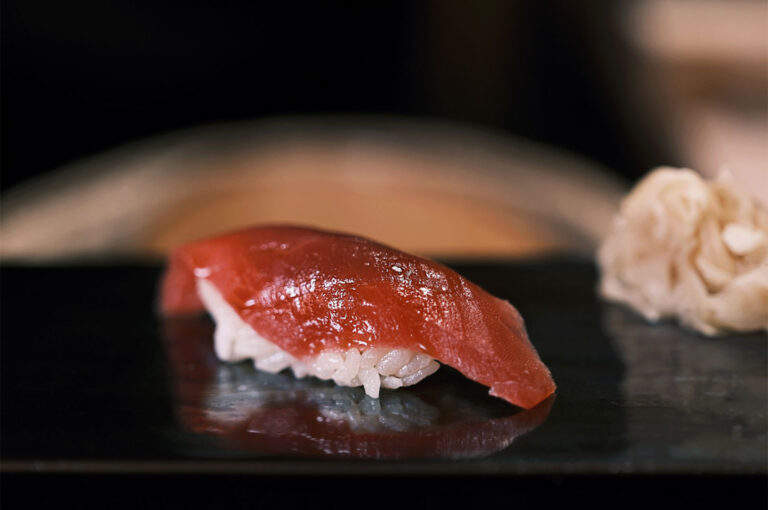
Conveyor Belt Sushi
Kaiten zushi (conveyor belt sushi) offers affordable, family-friendly dining with color-coded plates priced between 100 and 500 yen, where customers pay based on how many plates they take from the conveyor, often tracked by RFID tags. These restaurants provide accessible sushi with a mix of traditional preparations and modern variations while maintaining acceptable quality standards.
Counter-Style
Counter-style establishments offer traditional omakase experiences with direct chef interaction, emphasizing seasonal ingredients, technical skill, and personalized service. Sushi served piece by piece at the counter allows for educational exchanges and customized preparations, enhancing the chef-diner relationship.
Standing Sushi Bars
Standing sushi bars became popular in Tokyo train stations and business districts, offering quick, casual dining for busy professionals while maintaining high quality standards. Sushi served here is typically ordered and eaten quickly, catering to those on the go.
High-End Kaiseki-Style
High-end kaiseki-style restaurants incorporate sushi as one element within multi-course meals, showcasing seasonal ingredients through various preparation methods. These establishments represent the pinnacle of Japanese culinary artistry, where sushi serves specific roles within broader gastronomic narratives.
Each restaurant style serves unique social functions while maintaining the essential quality that defines authentic Japanese sushi. Sushi in Japan is enjoyed on conveyor belts, at counters, or in multi-course meals. From convenience stores to premium establishments, Japan’s sushi culture meets diverse tastes and occasions.
Seasonal Considerations in Japanese Sushi
Seasonality profoundly influences authentic Japanese sushi, reflecting the cultural principle of shun—consuming ingredients at their peak natural condition to optimize flavor, texture, and nutrition throughout the year.
Spring features celebrations like cherry blossom season with fresh vegetables and white fish such as sea bream gaining prominence. Summer emphasizes lighter, refreshing preparations like cucumber-based kappa maki and delicate white fish suited for warmer weather. Autumn offers premium seafood including saury (sanma) and migrating salmon, presenting a rich variety for sushi appreciation. Winter highlights richer fish preparations, with cold waters enhancing fat content in species like yellowtail and sea urchin, creating intense flavors favored by seasoned diners.
Seasonal omakase menus at Sushi Masa showcase the best ingredients year-round, respecting tradition while incorporating contemporary presentation. Preparation methods vary with seasons, such as cooling techniques in summer and gentle warming in winter, reflecting sensitivity to natural rhythms that distinguish authentic Japanese sushi from standardized commercial fare.
Embracing the Cultural Essence of Sushi in Japanese Tradition
Understanding sushi in Japanese reveals deep cultural significance beyond food preparation, encompassing ancient fermentation techniques, modern omakase experiences, and centuries of refinement.
At Sushi Masa, we honor these rich traditions through authentic techniques, seasonal ingredients, and cultural respect, offering diners a genuine experience of the art of Japanese sushi where every grain of vinegared rice and slice of fresh fish reflects centuries of culinary mastery. We invite you to experience the true art of sushi in Japanese tradition—come savor the harmony of carefully prepared vinegared rice and fresh fish crafted by our skilled sushi chef.

